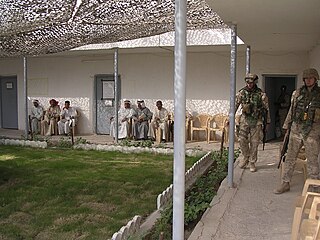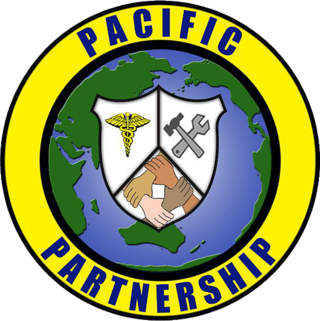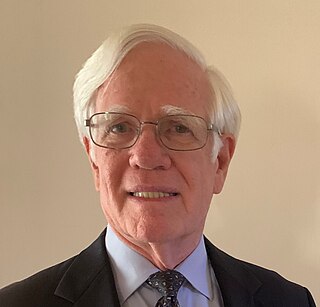
Civil defense or civil protection is an effort to protect the citizens of a state from human-made and natural disasters. It uses the principles of emergency operations: prevention, mitigation, preparation, response, or emergency evacuation and recovery. Programs of this sort were initially discussed at least as early as the 1920s and were implemented in some countries during the 1930s as the threat of war and aerial bombardment grew. Civil-defense structures became widespread after authorities recognised the threats posed by nuclear weapons.

USNS Mercy (T-AH-19) is the lead ship of her class of hospital ships in non-commissioned service with the United States Navy. Her sister ship is USNS Comfort (T-AH-20). She is the third US Navy ship to be named for the virtue mercy. In accordance with the Geneva Conventions, Mercy and her crew do not carry any offensive weapons, though defensive weapons are available.

A humanitarian crisis is defined as a singular event or a series of events that are threatening in terms of health, safety or well-being of a community or large group of people. It may be an internal or external conflict and usually occurs throughout a large land area. Local, national and international responses are necessary in such events.

The United Nations Office for the Coordination of Humanitarian Affairs (OCHA) is a United Nations (UN) body established in December 1991 by the General Assembly to strengthen the international response to complex emergencies and natural disasters. It is the successor to the Office of the United Nations Disaster Relief Coordinator (UNDRO).

The Defense Logistics Agency (DLA) is a combat support agency in the United States Department of Defense (DoD), with more than 26,000 civilian and military personnel throughout the world. Located in 48 states and 28 countries, DLA provides supplies to the military services and supports their acquisition of weapons, fuel, repair parts, and other materials. The agency also disposes of excess or unusable equipment through various programs.

The United States under secretary of defense for policy (USDP) is a high level civilian official in the United States Department of Defense. The under secretary of defense for policy is the principal staff assistant and adviser to both the secretary of defense and the deputy secretary of defense for all matters concerning the formation of national security and defense policy.
Frederick C. Cuny was an American humanitarian whose work spanned disaster relief, refugee emergency management, recovery from war and civil conflict as well as disaster and emergency preparedness, mitigation and peacebuilding. He was first and foremost a practitioner, but also a prolific author, an educator and a field-based researcher. He has been described as “a great American – a sort of universal Schindler, a man with lists of millions of people in Asia, Africa, Latin America and Europe whose lives he succored or saved.” Another tribute to Cuny claimed that he “was one of the world’s most accomplished disaster relief experts, both a pioneer and an iconoclast in the field of international humanitarian aid.”
Pacific Disaster Center (PDC) is an applied science, information and technology center, working to reduce disaster risks and impacts on life, property, and the economies worldwide.

A Cooperative Strategy for 21st Century Seapower is the United States' maritime strategy. It was originally presented by the U.S. Chief of Naval Operations and the Commandants of the U.S. Marine Corps and U.S. Coast Guard at the International Seapower Symposium at the U.S. Naval War College in Newport, Rhode Island on October 17, 2007. The new maritime strategy explains the comprehensive role of the sea services in an era marked by globalization and uncertainty.

A Civil Military Operations Center or CMOC is a center usually established by a military force for coordinating civil-military operations in an area of operations. This center usually serves as a meeting place for military and non-military entities involved in governance, stabilization, humanitarian relief and reconstruction activities or for interaction between the entities involved in these activities and the civilian population. Often, it also serves as a central location for information on civilian related activities in the area or maintains the status of the infrastructure or institutions. During combat operations, a CMOC is usually in a secure compound.
The 2009 Samoa earthquake and tsunami took place on 29 September 2009 in the southern Pacific Ocean adjacent to the Kermadec-Tonga subduction zone. The submarine earthquake occurred in an extensional environment and had a moment magnitude of 8.1 and a maximum Mercalli intensity of VI (Strong). It was the largest earthquake of 2009. The earthquake initiated with a normal-faulting event with a magnitude of 8.1. Within two minutes of the earthquake rupture, two large magnitude 7.8 earthquakes occurred on the subduction zone interface. The two magnitude 7.8 earthquakes had a combined magnitude equivalent to 8.0. The event can be considered a doublet earthquake.

Pacific Partnership is an annual deployment of forces from the Pacific Fleet of the United States Navy (USN), in cooperation with regional governments and military forces, along with humanitarian and non-government organizations.
Randell Stansfield is a former military officer of the United States.
The STAR-TIDES project is a global knowledge-sharing research network coordinated at the George Mason University (GMU). It is derived from a research project called TIDES which was originally a research effort for the Institute for National Strategic Studies (INSS) at the National Defense University (NDU)--part of the Department of Defense. The STAR-TIDES project promotes sustainable support to stressed populations – post-war, post-disaster, or impoverished, in foreign or domestic contexts, for short-term or long-term (multi-year) operations. The project provides reach-back “knowledge on demand” to decision-makers and those working in the field. It uses public-private partnerships and “whole-of-government” approaches to encourage unity of action among diverse organizations where there is no unity of command, and facilitates both inter-agency and international engagement.
Sahana Software Foundation is a Los Angeles, California-based non-profit organization founded to promote free and open-source software (FOSS) for disaster and emergency management. The foundation's mission statement is to "save lives by providing information management solutions that enable organizations and communities to better prepare for and respond to disasters." The foundation's Sahana family of software products includes Eden, designed for humanitarian needs management; Vesuvius, focused on the disaster preparedness needs of the medical community; and legacy earlier versions of Sahana software including Krakatoa, descended from the original Sahana code base developed following the 2004 Indian Ocean tsunami. The word "Sahana" means "relief" in Sinhalese, one of two national languages of Sri Lanka.

Eric David Rasmussen is an American physician specializing in methods for global disaster response and their intersection with modern medical ethics. He was selected as the founding CEO of the TED Prize awarded to Larry Brilliant of Google.org in 2006 and in 2013 became the CEO of Infinitum Humanitarian Systems, a Seattle-based international consulting firm specializing in the humanitarian sciences.
All Partners Access Network (APAN), formerly called Asia-Pacific Area Network, is a United States Department of Defense (USDOD) social networking website used for information sharing and collaboration. APAN is the premier collaboration enterprise for the USDOD. The APAN network of communities fosters multinational interaction and multilateral cooperation by allowing users to post multimedia and other content in blogs, wikis, forums, document libraries and media galleries. APAN is used for humanitarian assistance and disaster relief, exercise planning, conferences and work groups. APAN provides non-governmental organizations (NGOs) and U.S. partner nations who do not have access to traditional, closed USDOD networks with an unclassified tool to communicate.

Linton Wells II is an American public servant and educator who served a total of 51 years in government service. He served 26 years in the United States Navy as an officer, and then was appointed by the President of the United States as the Principal Deputy Assistant Secretary of Defense, serving through two administrations of both parties, both the Democrat Bill Clinton and the Republican George W. Bush. He wrote many books, articles, and white papers on matters of national security, including important texts related to the use of American military capabilities in global humanitarian operations. His expertise focused on the strategic impacts of technological change and on building resilience to natural and man-made disasters as issues of US national security. He shaped, over five decades of public service, current US Department of Defense directives that link policy and technology with public-private cooperation. His writings significantly altered U.S. and international approaches to civil-military engagement, US policy in global humanitarian assistance, and global public-private partnerships in disaster relief. He has also made fundamental contributions to technical areas that have defined network-enabled military capabilities and cyberspace operations. After retiring from public service, he continued to contribute to the international STAR-TIDES network that he had founded in 2007, a consortium of several thousand global nodes comprising agencies, organizations, institutions and individuals in 40+ countries that promote the free exchange of research results on global issues of human security. As of 2021 he is Executive Advisor to the Center for Resilient and Sustainable Communities (C-RASC) at George Mason University and chairs the Advisory Group of the C4I and Cyber Center there. C-RASC has been working with the People-Centered Internet (PCI) on ways to “put humanity at the center of the Internet” and support a variety of revitalization initiatives. He is on the board of PCI, and also the President and CEO of Global Resilience Strategies and Senior Advisor to Resilient Japan. He was listed by Fortune magazine in 2009 as one of the top 16 "Players of Tech".
Frederick M. "Skip" Burkle, Jr. is an American physician known for his work in human rights, international diplomacy and peacemaking, humanitarian assistance, and disaster response. He has been called "the single most talented and experienced post-conflict health specialist working for the United States government." His medical qualifications include pediatrics, emergency medicine, psychiatry, public health, and tropical medicine.











